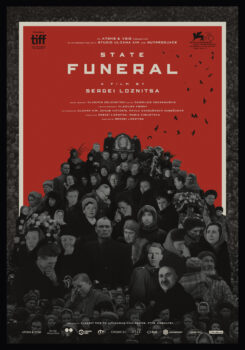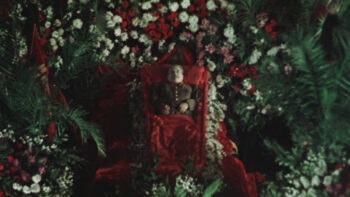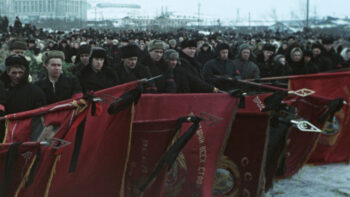Film Review: State Funeral (NZIFF 2020)
An epic Iliad cinema experience at the passing of the most influential person of the twentieth century, Josph Stalin. All the glory but none of the horror.
Director: Sergei Loznitza
 The man born Ioseb Jugashvili in Georgia to a poor family, would eventually transform an indescribably massive country from serfdom into the modern Industrial Age. And he led the country he ruled, to defeat the biggest man-made existential threat that humanity has ever seen.
The man born Ioseb Jugashvili in Georgia to a poor family, would eventually transform an indescribably massive country from serfdom into the modern Industrial Age. And he led the country he ruled, to defeat the biggest man-made existential threat that humanity has ever seen.
It is not correct to see this as result of a single man. He is the conduit by which history unfolded. He passed away as the Cold War was heating up, nine years before it also reached its existential crisis.
The footage that Director Loznitsa has restored, was originally shot for a final tribute movie of Stalin’s death called The Great Farewell. Thirty plus hours of footage shot across the vast landscape of Russia and her neighbouring countries. Also filmed at the time but not included here, montages in Paris, China, North Korea and Cambodia.
The colour footage is extremely vibrant and bright. Masses of flowers line streets and avenues around Moscow. Stalin himself in a glass-covered coffin, again surrounded by a Van Gogh explosion of colour.
This contrasts with black and white footage of ports, building sites and factories. Villages and small-town squares packed with taciturn inhabitants. Inuits on dogsleds travelling on ice and snow.
 There are the delegations being met at the airport runway. Peoples Republic of China, Poland, Romania, Hungary, German Democratic Republic. William Alexander of the British Communist Party arrives with an entourage.
There are the delegations being met at the airport runway. Peoples Republic of China, Poland, Romania, Hungary, German Democratic Republic. William Alexander of the British Communist Party arrives with an entourage.
The voice-over commentary comes from the numerous radio broadcasts at the time – hagiographic to the point of ridiculous over-bearing fawning. Such a strong, noble and honorable Being as has never been seen in the history of mankind. To add one minute to your precious life, we would give all our blood.
George Orwell’s dystopian nightmare gaining form.
First there was DW Griffiths Birth of a Nation (1915). The racist classic movie was also the first blockbuster, with massive staging sets involving thousands of extras. It was the story of the rise of the Klu Klux Klan and US President Woodrow Wilson had a special screening at the White House and declared it the American legacy as art. Which resulted in a huge increase in lynching against the black population in the Southern States.
 Then of course, Leni Riefenstahl’s Triumph of the Will (1935) and its deification of the Nazi regime, itself inspired by the above movie. But, just as Riefenstahl’s movie had the immune response as Charlie Chaplin’s The Great Dictator (1940), so we saw that last year with Armando Ianucci’s Death of Stalin (2019). A black comedy satire on the regime’s darkness and terror, and the machinations which went on to recover from it when Great Leader died.
Then of course, Leni Riefenstahl’s Triumph of the Will (1935) and its deification of the Nazi regime, itself inspired by the above movie. But, just as Riefenstahl’s movie had the immune response as Charlie Chaplin’s The Great Dictator (1940), so we saw that last year with Armando Ianucci’s Death of Stalin (2019). A black comedy satire on the regime’s darkness and terror, and the machinations which went on to recover from it when Great Leader died.
Some of the key figures appear with their public speeches. Lavrentia Beria, the hated head of the Secret Police, who would be assassinated later that year (1953). Georgy Malenkov, was interim head of state until removed by Khrushchev, acts as an MC of the proceedings. And Vyacheslav Molotov, the arch diplomat. All three on the way down, one for good.
As large as the processions are of the military and the dignitaries, the most majestic is the footage of the crowd building up to watch the official procession. People stare at the camera in a daze. Some break down and weep. Likely for the loss of the Leader as well as the memory of people lost in the waves of terror.
Eyewitness reports and journalist’s coverage also testify to what is not on film. The massive waves of people caught in crushes and trampled. The casualties.
The sound restoration is superb. Original music score is retained. The thunder of a forty-gun canon salute.
After 135 minutes of spectacle, the movie ends with the death toll. Silently.
27 million murdered, executed, tortured, imprisoned. 15 million starved to death.
Two years after the state funeral, Stalin and his legacy were repudiated. In 1961, his body was removed from the mausoleum and buried in the Moscow wall.
State Funeral is showing as part of the NZ International Film Festival. For tickets/online access, please go HERE.
Rev Orange Peel
- No Broadcast – The Common Thread (Album Review) - May 14, 2023
- Rita Mae – Whammy Bar, May 5, 2023 (Concert Review) - May 6, 2023
- Dictaphone Blues – Greetings from Glen Eden (EP Review) ⭐⭐⭐ - May 4, 2023
